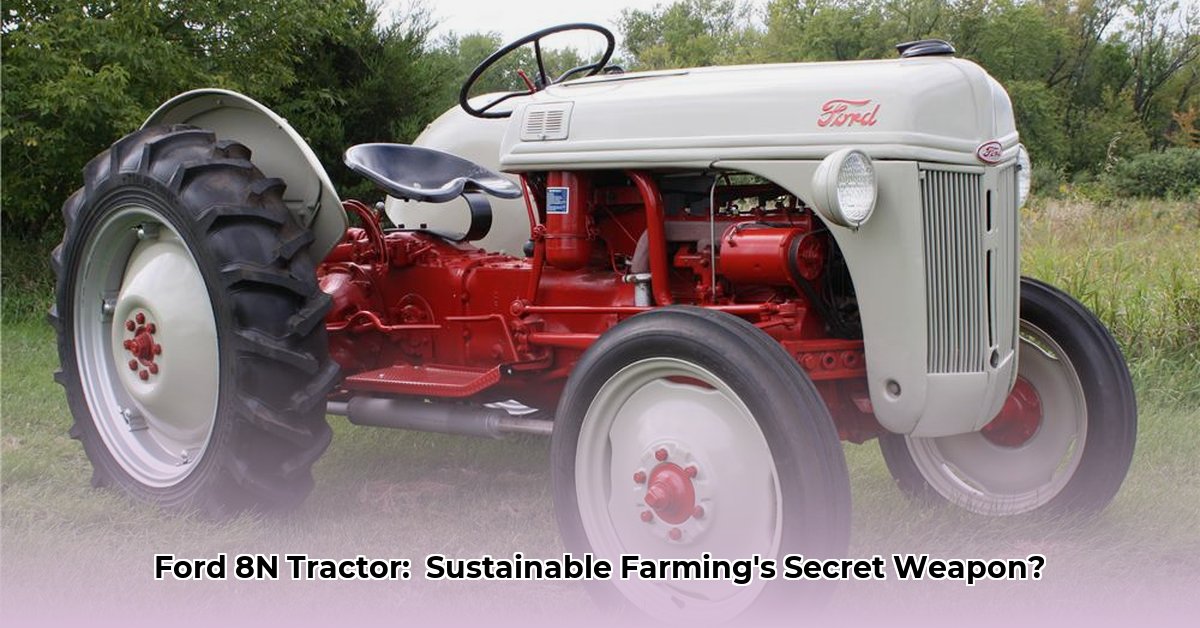
Ford 8N Tractor Weight: Specifications and Historical Context
The Ford 8N tractor, a pivotal machine in the history of agriculture, presents a compelling case study in the interplay between technology, sustainability, and agricultural practices. Understanding its weight is crucial to comprehending its impact. While precise weight varied based on configuration and added implements, the base weight of a Ford 8N generally ranged from 2,500 to 2,800 pounds.1 This seemingly simple figure significantly impacts several key aspects of its operation and long-term sustainability. For more detailed wiring diagrams, see this helpful resource: 8N Wiring Diagram.
Weight, Traction, and Soil Compaction: A Delicate Balance
The 8N's weight directly affected its traction, particularly in challenging soil conditions. Sufficient weight was necessary for effective plowing and tillage, preventing wheel spin. However, excessive weight contributed to soil compaction, hindering water infiltration and root development. This compaction negatively impacts soil health and long-term agricultural sustainability. The optimal weight for a given task depended heavily on the soil type and moisture content. Dry soil requires less weight than wet soil to achieve sufficient traction, but the risk of compaction increases significantly in wet conditions.
Fuel Efficiency and the Environmental Footprint
The 8N's weight, along with its engine design and operational parameters, influenced its fuel consumption. A heavier tractor requires more power, resulting in increased fuel usage. While the 8N was comparatively lightweight when compared to modern tractors, its fuel efficiency was still a significant factor in its overall environmental impact. Given fluctuating fuel prices throughout its operational history, the discussion of fuel efficiency highlights the multifaceted relationship between agricultural productivity and resource conservation.
The 8N's Legacy: A Comparative Perspective on Sustainable Practices
The Ford 8N, revolutionary for its time, facilitated enhanced agricultural productivity. However, its relatively low horsepower often necessitated the use of multiple implements to complete larger-scale tasks. This increased the overall fuel consumption and raised questions regarding the environmental impact even of early mechanization. Examining this aspect reveals that past sustainability efforts need to be reassessed in light of our current, more nuanced understanding of environmental concerns.
Durability and the Extended Lifespan Advantage
One notable aspect of the 8N is its remarkable durability; many remain operational today. This longevity presents a significant environmental benefit. The extended lifespan minimizes the need for frequent replacements, reducing resource consumption associated with manufacturing and disposal, thus lowering the overall environmental footprint across the machine's operational life.
Detailed Weight Analysis and its Impact on Sustainable Farming
The following table summarizes the key factors influencing the Ford 8N's weight and its effect on sustainable agricultural practices:
| Factor | Details | Impact on Sustainable Farming |
|---|---|---|
| Ford 8N Base Weight | Approximately 2,500 to 2,800 pounds | Affects traction, soil compaction, and fuel consumption |
| Added Equipment Weight | Varies greatly depending on tools used | Significantly increases weight and soil compaction risk |
| Fuel and Operator Weight | Adds to overall machine weight | Minor impact individually, but cumulative effect over time is significant |
| Soil Type and Moisture Level | Drastically affects needed weight for optimal traction | Dry soil needs less weight than wet; compaction risk higher in wet conditions |
| Fuel Efficiency | Directly impacted by weight and operating conditions | A major factor in assessing overall environmental impact |
Assessing the Environmental Impact: A Multifaceted Approach
The environmental impact of the Ford 8N extends beyond its operational weight. Several factors contribute to its overall assessment:
Weight and Fuel Consumption: The tractor's weight directly impacts its fuel efficiency, leading to varying levels of greenhouse gas emissions. Higher weight correlates with higher fuel consumption.
Manufacturing Impact: The materials and manufacturing processes used in the 1940s and 50s generated emissions, representing an inherent environmental footprint.
Longevity and Maintenance: The 8N’s relatively simple design and readily available parts facilitate easier repair and maintenance, minimizing waste compared to modern, often less repairable tractors. The machine's extended lifespan significantly reduces the overall resource consumption associated with its lifecycle.
Operational Practices: The tractor’s lower horsepower may necessitate slower, potentially more sustainable farming techniques, reducing soil erosion and mitigating some of the negative impacts of higher fuel consumption.
Key Considerations: A comprehensive assessment necessitates a comparative analysis between the 8N and modern tractors performing similar tasks. This comparison needs to incorporate fuel efficiency, emissions, manufacturing impact, maintenance needs, and, crucially, operational practices throughout the entire lifecycle of both the classic and modern tractors.
1TractorData (Note: While exact weights on Tractordata vary slightly depending on configuration, the range cited reflects general consensus within historical sources.)